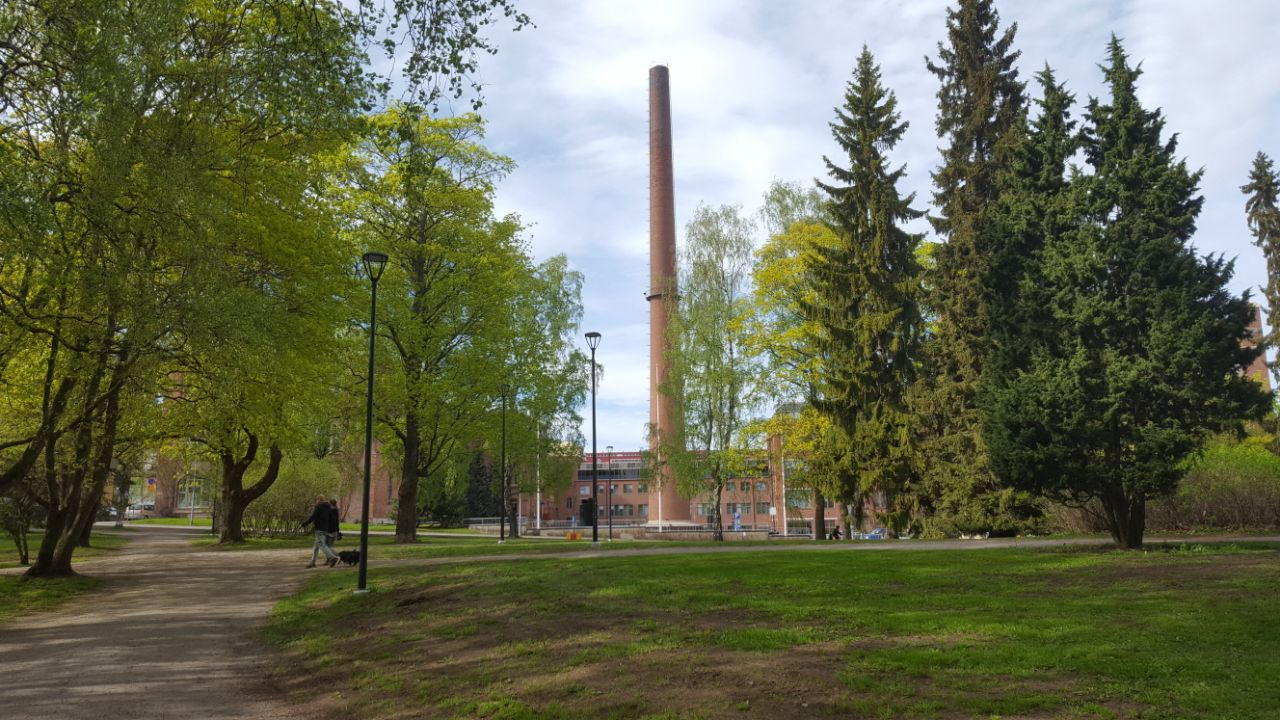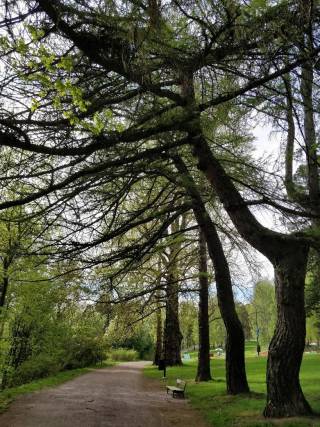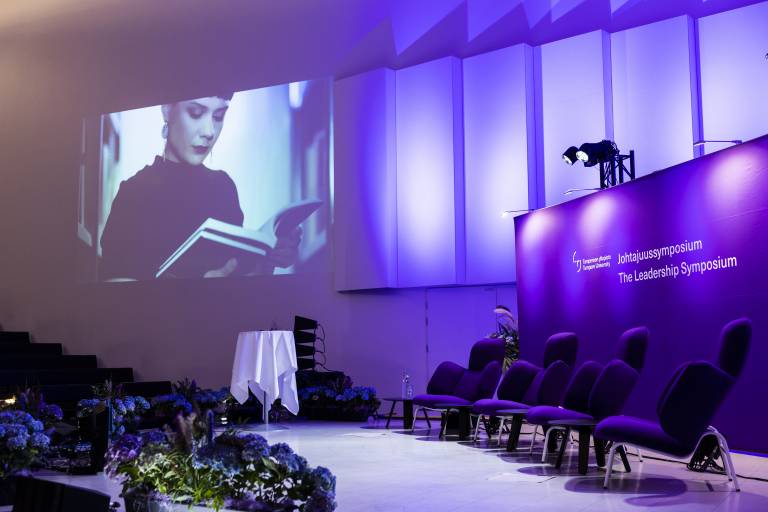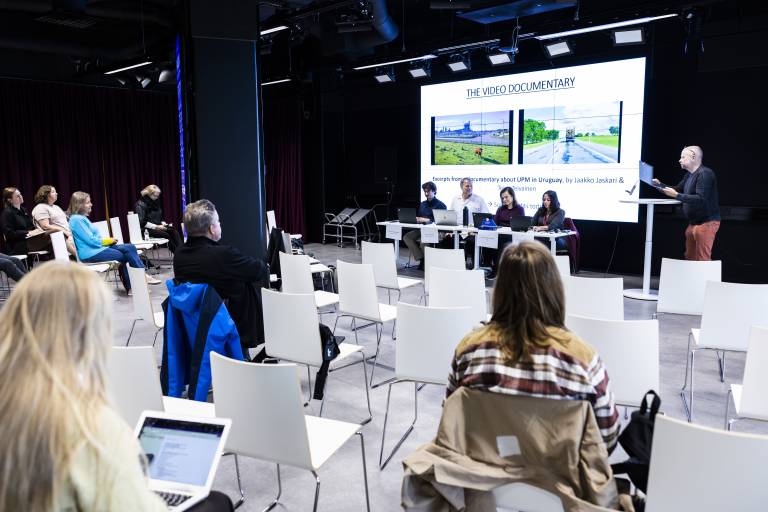I am Eteläpuisto. I was born to be a park in the 1830s in the city of Tampere, Finland. I am located at the southern end of Hämeenpuisto park, and my friends have called me “the lungs of Tampere”. I am the green gate to lake Pyhäjärvi, and I protect its shore, connecting the city to the Pyynikki parks. My landscape features wide walking tracks and a stable ground.
In this blog post, I will talk about how, together with my friends, I have been fighting for our right to exist against threats of urban planning and development, and why we have been successful until now.
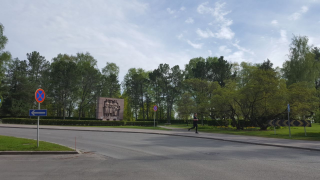
Connecting point of Hämeenpuisto and Eteläpuisto. Photo by Tatjana Blum.
Urban development brought me into existence – but currently, it is threatening to remove me
The City of Tampere is growing to be an attractive place to live, play and work, and holds appeal as a second home location for many. In 2020, Tampere was even announced the most attractive city to move to among Finnish people. I can understand why – I love living here, as Tampere is a place with a unique soul. This growth brought positive changes to the city, and the newcomers give me a lot of excitement. In this, the real estate investors saw as an opportunity to increase their profit. And there is no problem in seeking profit per se – although I am park, I understand the concept of ‘paying bills’ and ‘having a roof during the winter months’.
However, the increased pressure for construction, especially for luxurious housing, has taken a toll on nature and many of my friends. There are new neighborhoods such as Hiedanranta and Vuores in Tampere that are answering to the needs of new housing in this growing city. Nevertheless, there is a public discussion and even some action to direct the building plans in a more sustainable way from the perspective of nature and humans. Tampereen luonnonsuojeluyhdistys made a petition in February 2021 to re-evaluate the decision of the Administrative Court in relation to water-planning in Hiedanranta. The construction plans of Vuores were criticized in the beginning because of the area being built in the middle of nature. This is the reason why sustainable solutions have been incorporated in its construction as a compensation for nature.
 I do not believe that replacing natural spaces with housing is the sustainable way to go, as what makes Tampere attractive is the combination and balance of city and nature. When it comes to my specific case, we started noticing something was wrong in 2011, when an international competition of construction design was announced for a new set of buildings on my territory. The winning enterprise proposed the partial destruction of the park, replacing it with new houses. This planning happened very fast and was a big surprise to many Tampere citizens. Thanks to urban activists, the project was postponed. Through collective action, they highlighted the benefits of natural areas for human well-being and showed the importance of biodiversity for the city. Still, nowadays, there are some who want to destroy me, to remove my old trees and green spaces to construct apartment buildings on my soil.
I do not believe that replacing natural spaces with housing is the sustainable way to go, as what makes Tampere attractive is the combination and balance of city and nature. When it comes to my specific case, we started noticing something was wrong in 2011, when an international competition of construction design was announced for a new set of buildings on my territory. The winning enterprise proposed the partial destruction of the park, replacing it with new houses. This planning happened very fast and was a big surprise to many Tampere citizens. Thanks to urban activists, the project was postponed. Through collective action, they highlighted the benefits of natural areas for human well-being and showed the importance of biodiversity for the city. Still, nowadays, there are some who want to destroy me, to remove my old trees and green spaces to construct apartment buildings on my soil.
Why should I live? Because of the Ubuntu philosophy – “I am because we are”
“I am because we are” is an Ubuntu philosophy. According to sociologists, it illustrates a shared understanding that is common in many African cultures. This understanding states that an individual, a human being, is part of a larger relational, societal, environmental and spiritual community.
Although I am Finnish, and although I am not human, I feel my existence is Ubuntu – I am Eteläpuisto because of the many connections that define me. Ubuntu determines that a person is a person through other persons. If you allow me to be radical here, I will expand my idea of an Ubuntu existence even further: My existence is not defined in an intrinsic or essential way, but it happens through the unique relations I establish with other beings, such as trees, squirrels, insects, emotions, perspectives, events. Because of my existence, birds have trees to build their nests, the elderly have paths to walk, and teenagers have areas to enjoy BBQs and summer drinks.

Summer terrace next to the lake invites everyone to enjoy a relaxing moment. Photo by Tatjana Blum.

If humans are fed water, food and oxygen, they survive. But a real and thriving existence also includes time in nature, relationships with other humans, access to biodiversity, leisure and recreation. In this, I am happy to say that my landscape, fauna and flora have contributed to the Ubuntu existence of many who visit me, and significantly to the health and well-being of the city. Therefore, I should live: if you kill me, you will also deny the right of existence to many others, because we live in the world as relations.
The meaning of Ubuntu is echoed in what post-humanist scholars call ‘distributive agency’. It emphasizes the relational aspects of human agency (not just human existence) and implies that humans cannot exercise their will and get active without the relationship with their non-human environment. Agency results from the associations and connections with other humans and non-humans and is never an independent process. Human environmental activism is often based on immediate sensory experiences – as is the case with my human friends from Eläköön Eteläpuisto. They come to visit me often and feel a deep connection with me, their beloved park. They have given me their hearts and their voices to fight for my preservation. I speak through them.
Urban activism gives hope for community-led social change
I am a park, I have lived through different epochs, and I have seen different generations and histories of human beings together, so I learned that a common aspect among different stories of social change lies in communities. In this, communities need physical spaces to thrive. In urban activism, spaces allow for activists to challenge the uses intended by municipalities. Across the globe, notions of space and territory have formed the foundation for spatial insurgency and community activism to foster social change in pursuit of a new society. Thanks to my ground and soil, and thanks to the space I offer for many different activities, activists united to imagine the city they want for the future.
The paths of Eteläpuisto are framed by beautiful trees. Photo by Sari Veripää.

Paddle courts in Eteläpuisto. Photo by Tatjana Blum.
In that regard, the ones who want to destroy me are not the majority! Thousands of citizens have signed the petition in which they oppose my destruction. Thanks to me, an entire debate between university professors, activists, citizens and public officials started regarding urban development. Thanks to my old trees, my paths, and the animals that live here, nature became a central topic in the municipal council elections. I am happy to create the space by which humans can convene to talk about their shared goals and future. We also have allies in the municipality’s administration, and because of them, my future is a bit more certain now than it was before.
When talking about urban civic activism nowadays, the internet has become an important platform to share information and inspire people. It works well also to organize and get more people involved in important causes such as saving me. I am very grateful for the good work done by Eläköön Eteläpuisto and the way they have managed to reach more and more people through the internet as a platform in their website and on Facebook.

Lakeside path offers beautiful views to Pyhäjärvi lake. Photo by Tatjana Blum.
What can you do to help our cause?
I am not the only park under threat of urban development. There are some natural areas in Tampere subject to redesign, removal and destruction. For example, as mentioned, some people have warned about the dangers of building Hiedanranta’s dam over the lake.
- You can support our cause by enjoying the perks of what I have to offer – my accessible paths, the grilling areas as well as the fields for doing sports. Benefiting from me is one of the main ways to show my importance to the municipality and the society.
- You can support us by attending Eläköön Eteläpuisto’s meetings and activities
- You can influence with your vote in the Council elections
- Spread the word! Tell your friends and family about me, share the petition or Eläköön Eteläpuisto’s social media (Instagram & Facebook) and blog.
Many people wonder – if a park could speak, what would it say? Here is the answer:
I want to live.
Sources
- Jon, I. (2020). Decipheringposthumanism: Why and how it matters to urban planning in the Anthropocene. Planning Theory, 19(4), 392–420.
- Lopes de Souza, M. (2016). Lessons from Praxis: Autonomy and Spatiality in Contemporary Latin American Social Movements. Antipode, 48(5), 1292–1316.
- Mäenpää, P. & Faehnle, M. (2017). Civic activism as a resource for cities. Helsinki Quarterly, 1/2017.
- Ngcoya, M. (2015). Ubuntu: Toward an Emancipatory Cosmopolitanism? International Political Sociology, 9(3), 248–262.
- Ngunjiri, F. W. (2016). “I Am Because We Are”: Exploring Women’s Leadership Under Ubuntu Worldview. Advances in Developing Human Resources, 18(2), 223–242.
- Venttola, E. (2020, 4/15). Suomen paras kaupunki: Tampere on halutuin muuttokohde kaikkialla Suomessa. Retrieved from: https://www.aamulehti.fi/pirkanmaa/art-2000007452304.html


